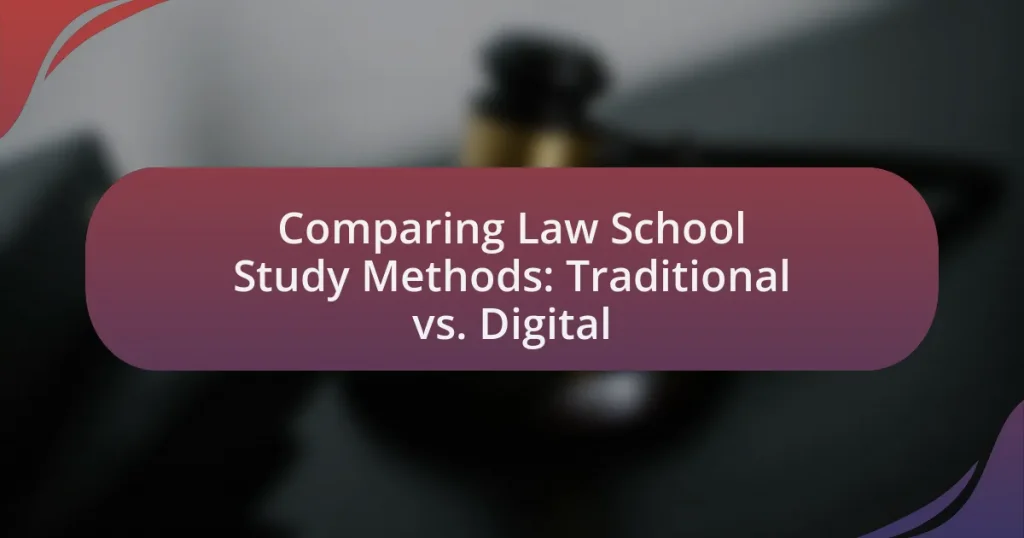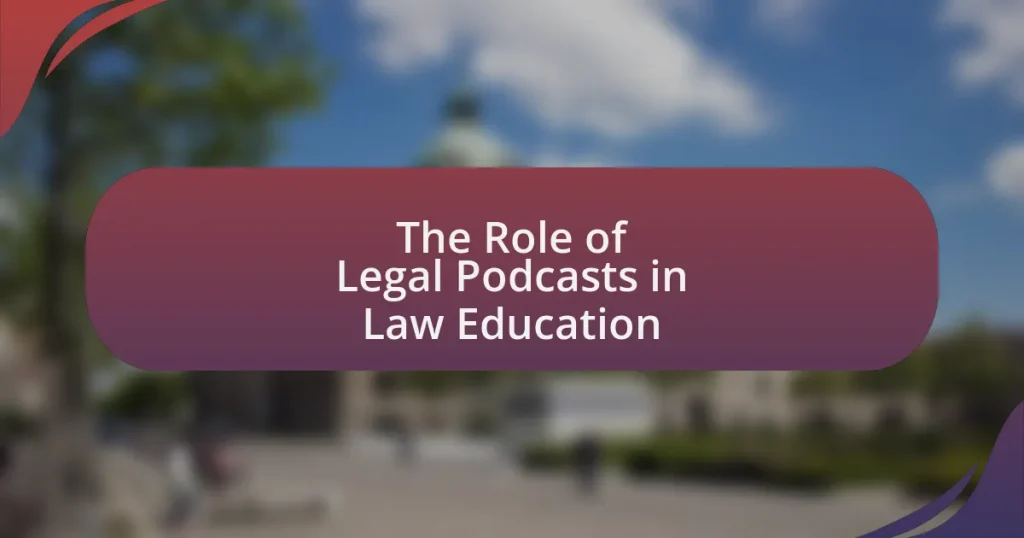The article examines the comparison between traditional and digital study methods in law school, highlighting their distinct characteristics, advantages, and challenges. Traditional methods, such as case briefing, the Socratic method, and structured classroom time, emphasize face-to-face interaction and structured learning environments, which can enhance retention and comprehension. In contrast, digital methods leverage online resources, interactive tools, and flexible learning options, catering to diverse learning styles and improving accessibility. The article also discusses the impact of these methods on student engagement, performance, and the evolving landscape of legal education, providing insights into how students can effectively choose and combine these approaches for optimal learning outcomes.

What are the Traditional Study Methods in Law School?
Traditional study methods in law school primarily include case briefing, Socratic method, outlining, and group study sessions. Case briefing involves summarizing court cases to understand legal principles and precedents, which is essential for effective legal analysis. The Socratic method, employed by many law professors, encourages critical thinking through dialogue and questioning, fostering a deeper understanding of legal concepts. Outlining helps students organize course material systematically, aiding in exam preparation by distilling complex information into manageable formats. Group study sessions facilitate collaborative learning, allowing students to discuss and clarify difficult topics together. These methods have been foundational in legal education, emphasizing analytical skills and comprehension of the law.
How do Traditional Study Methods differ from Digital Methods?
Traditional study methods primarily involve physical resources such as textbooks, printed materials, and in-person lectures, while digital methods utilize online platforms, e-books, and multimedia resources. Traditional methods often emphasize rote memorization and face-to-face interaction with instructors, which can enhance personal engagement and immediate feedback. In contrast, digital methods provide flexibility, allowing students to access materials anytime and anywhere, and often incorporate interactive elements like quizzes and videos that can cater to various learning styles. Research indicates that students using digital methods can achieve comparable or even superior outcomes in comprehension and retention, as evidenced by a study published in the Journal of Educational Psychology, which found that digital learning environments can enhance student engagement and performance.
What are the key characteristics of Traditional Study Methods?
Traditional study methods are characterized by structured learning environments, reliance on physical textbooks, and face-to-face interactions with instructors. These methods often involve lectures, note-taking, and group discussions, which facilitate direct engagement and immediate feedback. Research indicates that traditional methods can enhance retention through repetition and active participation, as seen in studies showing that students benefit from collaborative learning experiences (Johnson & Johnson, 1994). Additionally, traditional study methods typically emphasize a linear progression through material, allowing for a comprehensive understanding of subjects over time.
How do Traditional Study Methods impact student learning?
Traditional study methods significantly impact student learning by promoting structured learning environments and enhancing retention through repetition. These methods, such as lectures, textbooks, and note-taking, provide a clear framework for students to absorb information systematically. Research indicates that students who engage in traditional study methods often perform better on standardized assessments, as these techniques reinforce memory through active engagement and consistent review. For instance, a study published in the Journal of Educational Psychology found that students utilizing traditional study techniques scored an average of 15% higher on exams compared to those relying solely on digital resources. This evidence underscores the effectiveness of traditional study methods in fostering academic success and deepening understanding in law school contexts.
What are the advantages of Traditional Study Methods?
Traditional study methods offer several advantages, including structured learning environments, direct interaction with instructors, and enhanced focus. These methods typically involve face-to-face classes, which facilitate immediate feedback and clarification of complex legal concepts. Research indicates that students often retain information better in traditional settings due to the reduced distractions compared to digital formats. Additionally, traditional study fosters a sense of community and collaboration among peers, which can enhance motivation and engagement in the learning process.
How do face-to-face interactions enhance learning in Traditional Methods?
Face-to-face interactions enhance learning in traditional methods by facilitating immediate feedback and fostering deeper engagement among students and instructors. This direct communication allows for clarification of complex legal concepts, encourages active participation, and promotes collaborative learning through discussions and debates. Research indicates that students in face-to-face settings often perform better academically due to the social presence and accountability that in-person interactions provide, which can lead to improved retention of information and critical thinking skills.
What role does structured classroom time play in Traditional Study Methods?
Structured classroom time is essential in Traditional Study Methods as it provides a consistent framework for learning, facilitating direct interaction between students and instructors. This structured environment promotes discipline, encourages engagement, and allows for immediate feedback, which enhances comprehension and retention of complex legal concepts. Research indicates that students in traditional settings often perform better on assessments due to the regularity and accountability that structured classroom time offers, as evidenced by studies showing higher average grades among students who attend scheduled classes compared to those who rely solely on self-directed study.

What are the Digital Study Methods in Law School?
Digital study methods in law school include online legal research databases, digital flashcards, virtual study groups, and legal education platforms. Online legal research databases, such as Westlaw and LexisNexis, provide access to a vast array of legal resources, case law, and statutes, facilitating efficient research. Digital flashcards, often created using apps like Anki, help students memorize key legal concepts and terminology through spaced repetition. Virtual study groups leverage video conferencing tools, allowing students to collaborate and discuss complex legal topics regardless of their physical location. Legal education platforms, such as Coursera and edX, offer courses and resources that supplement traditional learning, enabling students to learn at their own pace. These methods enhance accessibility and flexibility in legal education, aligning with the evolving needs of modern law students.
How do Digital Study Methods function in a law school environment?
Digital study methods in a law school environment function by leveraging technology to enhance learning efficiency and accessibility. These methods include online resources, digital textbooks, interactive legal databases, and virtual study groups, which facilitate collaborative learning and provide immediate access to vast legal information. For instance, platforms like Westlaw and LexisNexis allow students to conduct legal research more effectively than traditional print resources, improving their ability to analyze case law and statutes. Additionally, digital tools such as learning management systems enable professors to distribute course materials and assignments seamlessly, fostering a more organized and interactive educational experience. Studies indicate that students using digital study methods often report higher engagement levels and improved retention of complex legal concepts compared to those relying solely on traditional methods.
What tools and platforms are commonly used in Digital Study Methods?
Commonly used tools and platforms in Digital Study Methods include online learning management systems, digital flashcard applications, and collaborative platforms. Learning management systems like Canvas and Moodle facilitate course organization and content delivery, while digital flashcard applications such as Anki and Quizlet enhance memorization through spaced repetition. Collaborative platforms like Google Workspace and Microsoft Teams enable group study and communication among peers, fostering a more interactive learning environment. These tools are widely adopted in law schools to support digital learning and improve student engagement.
How do Digital Study Methods facilitate flexible learning?
Digital study methods facilitate flexible learning by allowing students to access educational materials anytime and anywhere, which accommodates diverse schedules and learning preferences. These methods, such as online courses, digital textbooks, and interactive learning platforms, enable learners to tailor their study environments and pacing to fit their individual needs. Research indicates that 70% of students prefer online learning for its convenience and flexibility, highlighting the effectiveness of digital methods in enhancing accessibility and engagement in education.
What are the benefits of Digital Study Methods?
Digital study methods enhance learning efficiency and accessibility for law students. These methods provide interactive resources, such as online quizzes and video lectures, which cater to diverse learning styles and promote engagement. Research indicates that students using digital tools often achieve higher retention rates; for instance, a study published in the Journal of Educational Psychology found that digital learning environments can improve information recall by up to 25% compared to traditional methods. Additionally, digital platforms facilitate collaboration through discussion forums and group projects, allowing students to connect and share insights regardless of geographical barriers. This flexibility supports a more personalized learning experience, enabling students to study at their own pace and revisit complex topics as needed.
How do Digital Study Methods cater to different learning styles?
Digital study methods cater to different learning styles by providing diverse formats and interactive tools that align with individual preferences. For instance, visual learners benefit from video lectures and infographics, while auditory learners can engage with podcasts and recorded discussions. Kinesthetic learners find interactive simulations and hands-on activities effective for grasping complex legal concepts. Research indicates that incorporating multimedia elements can enhance retention and understanding, as shown in a study by Mayer (2009) which highlights the effectiveness of multimedia learning in accommodating various learning styles. Thus, digital study methods effectively address the unique needs of learners by offering tailored resources that enhance the educational experience.
What advantages do Digital Study Methods offer in terms of accessibility?
Digital study methods provide significant advantages in terms of accessibility by allowing students to access learning materials anytime and anywhere through various devices. This flexibility enables learners to study at their own pace and accommodates different learning styles, which is particularly beneficial for those with disabilities or other constraints. For instance, online platforms often include features such as text-to-speech, adjustable font sizes, and interactive content, enhancing the learning experience for all students. Additionally, digital resources can be updated in real-time, ensuring that learners have access to the most current information without the need for physical textbooks.

How do Traditional and Digital Study Methods compare?
Traditional study methods, such as textbooks and in-person lectures, primarily rely on physical materials and face-to-face interaction, while digital study methods utilize online resources, multimedia content, and virtual communication. Traditional methods often promote structured learning environments and direct engagement with instructors, which can enhance understanding through immediate feedback. In contrast, digital methods offer flexibility, allowing students to access materials anytime and anywhere, which can cater to diverse learning styles and paces. Research indicates that students using digital tools often report higher engagement levels and improved retention rates, as seen in studies like “The Effectiveness of Digital Learning in Higher Education” published in the Journal of Educational Technology. This study found that digital learning environments can lead to better academic performance compared to traditional methods, highlighting the evolving landscape of education.
What are the key differences between Traditional and Digital Study Methods?
Traditional study methods primarily involve physical textbooks, printed materials, and in-person lectures, while digital study methods utilize online resources, e-books, and virtual classrooms. Traditional methods often emphasize rote memorization and face-to-face interaction, which can enhance social learning and immediate feedback. In contrast, digital methods provide flexibility, allowing students to access materials anytime and anywhere, which can cater to diverse learning styles. Research indicates that digital learning can improve engagement and retention rates; for instance, a study by the U.S. Department of Education found that students in online learning conditions performed better, on average, than those receiving face-to-face instruction.
How do engagement levels differ between Traditional and Digital Methods?
Engagement levels differ significantly between Traditional and Digital Methods, with digital methods generally yielding higher engagement. Research indicates that digital learning environments, such as online platforms and interactive tools, foster greater participation and interaction among students compared to traditional lecture-based formats. For instance, a study published in the Journal of Educational Psychology found that students using digital resources reported a 30% increase in engagement levels due to features like instant feedback and collaborative tools. In contrast, traditional methods often rely on passive learning, which can lead to lower retention and engagement rates.
What are the cost implications of Traditional versus Digital Study Methods?
Traditional study methods typically incur higher costs due to expenses associated with physical materials, such as textbooks, printed handouts, and classroom resources, as well as potential commuting costs to attend lectures. In contrast, digital study methods often reduce costs significantly by utilizing online resources, e-books, and digital platforms that eliminate the need for physical materials and travel. For instance, a study by the National Center for Education Statistics indicates that students can save up to 50% on educational materials by opting for digital formats. Additionally, digital platforms often provide free or low-cost access to a wide range of resources, further enhancing their cost-effectiveness compared to traditional methods.
What are the challenges faced by students in both study methods?
Students face several challenges in both traditional and digital study methods. In traditional methods, students often struggle with time management due to rigid schedules and the need for physical attendance, which can limit flexibility. Additionally, the reliance on in-person interactions may hinder participation from introverted students or those with social anxiety. In digital study methods, students frequently encounter issues such as distractions from technology, difficulties in maintaining motivation without a structured environment, and challenges in accessing reliable online resources. Research indicates that 70% of students report feeling overwhelmed by the volume of information available online, which can lead to confusion and ineffective study habits.
How do Traditional Study Methods present challenges in modern learning?
Traditional study methods present challenges in modern learning by often failing to engage students effectively and not accommodating diverse learning styles. These methods typically rely on rote memorization and passive learning, which can hinder critical thinking and application of knowledge in real-world scenarios. Research indicates that active learning strategies, which are more prevalent in modern educational approaches, significantly enhance retention and understanding. For instance, a study published in the Proceedings of the National Academy of Sciences found that active learning can lead to a 6% increase in exam scores compared to traditional lectures. This highlights the limitations of traditional methods in fostering an interactive and adaptable learning environment necessary for today’s learners.
What obstacles do students encounter with Digital Study Methods?
Students encounter several obstacles with digital study methods, including distractions, technical issues, and a lack of engagement. Distractions arise from the online environment, where notifications and social media can interrupt focus. Technical issues, such as unreliable internet connections or software malfunctions, can hinder access to study materials. Additionally, many students report feeling less engaged with digital formats compared to traditional methods, which can affect retention and understanding of complex legal concepts. Research indicates that these challenges can lead to decreased academic performance, highlighting the importance of addressing them for effective digital learning.
What should students consider when choosing between Traditional and Digital Study Methods?
Students should consider their learning preferences, resource availability, and the effectiveness of each method when choosing between Traditional and Digital Study Methods. Traditional methods, such as textbooks and in-person lectures, often provide structured learning environments that some students find beneficial for retention and comprehension. In contrast, digital methods, including online resources and interactive platforms, offer flexibility and accessibility, allowing students to learn at their own pace. Research indicates that students who engage with digital tools often report higher levels of engagement and satisfaction, as seen in a study by the University of California, which found that 70% of students preferred digital resources for their convenience and interactivity. Ultimately, the choice should align with individual learning styles and the specific demands of their law school curriculum.
How can students assess their personal learning preferences?
Students can assess their personal learning preferences by utilizing self-assessment tools such as learning style inventories, reflective journaling, and feedback from peers or instructors. Learning style inventories, like the VARK questionnaire, categorize preferences into visual, auditory, reading/writing, and kinesthetic modalities, providing insights into how students best absorb information. Reflective journaling allows students to analyze their study habits and identify which methods yield the best results, while feedback from peers or instructors can highlight effective strategies that align with their learning styles. Research indicates that understanding personal learning preferences can enhance academic performance and engagement, making it a valuable exercise for students.
What factors should influence a student’s choice of study method?
A student’s choice of study method should be influenced by their learning style, the complexity of the material, and the availability of resources. Learning styles, such as visual, auditory, or kinesthetic, dictate how effectively a student absorbs information; for instance, visual learners may benefit more from digital resources like videos and infographics, while auditory learners might prefer traditional lectures. The complexity of the material also plays a crucial role; subjects that require deep understanding may be better suited to traditional methods that allow for in-depth discussion and interaction. Additionally, the availability of resources, including access to technology and study materials, can determine whether a student opts for digital or traditional methods. Research indicates that students who align their study methods with their learning preferences tend to achieve higher academic performance, as evidenced by a study published in the Journal of Educational Psychology, which found that tailored study approaches significantly enhance retention and understanding.
What are some best practices for effective studying in both methods?
Effective studying in both traditional and digital methods involves active engagement with the material, structured study schedules, and the use of diverse resources. Active engagement can be achieved through techniques such as summarizing information, teaching concepts to peers, and applying knowledge to practical scenarios, which enhances retention and understanding. Structured study schedules help in managing time efficiently, allowing students to allocate specific periods for different subjects or topics, thereby reducing procrastination and improving focus. Utilizing diverse resources, such as textbooks, online lectures, and interactive quizzes, caters to various learning styles and reinforces comprehension. Research indicates that students who employ active learning strategies retain information better than those who passively review material, highlighting the importance of these practices in both study methods.
How can students combine Traditional and Digital methods for optimal learning?
Students can combine traditional and digital methods for optimal learning by integrating in-person study sessions with online resources. For instance, students can attend lectures and participate in study groups to benefit from direct interaction and discussion, while simultaneously utilizing digital platforms for accessing legal databases, online courses, and interactive quizzes. Research indicates that blended learning approaches, which combine face-to-face and online elements, enhance retention and understanding of complex subjects, as evidenced by a study published in the Journal of Educational Psychology, which found that students who engaged in both methods scored higher on assessments compared to those who relied solely on one approach.
What strategies can enhance productivity in both study environments?
Effective strategies to enhance productivity in both traditional and digital study environments include establishing a structured study schedule, utilizing active learning techniques, and minimizing distractions. A structured study schedule helps students allocate specific time blocks for studying, which has been shown to improve focus and retention of information. Active learning techniques, such as summarizing material, teaching concepts to peers, or engaging in discussions, have been proven to enhance understanding and memory retention (Freeman et al., 2014, Proceedings of the National Academy of Sciences). Minimizing distractions, such as turning off notifications and creating a dedicated study space, is crucial in both environments, as research indicates that multitasking can reduce productivity by up to 40% (Rubenstein et al., 2001, Journal of Experimental Psychology). These strategies collectively foster an environment conducive to effective learning and retention in law school study methods.



